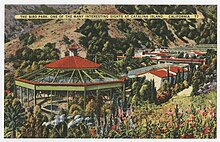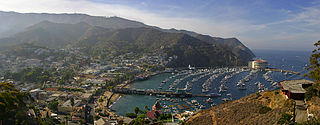
Avalon is the only incorporated city on Santa Catalina Island, in the California Channel Islands, and the southernmost city in Los Angeles County. The city is a resort community with the waterfront dominated by tourism-oriented businesses. The older parts of the town on the valley floor consist primarily of small houses and two and three-story buildings in various traditional architectural styles.

Wrigley Field was a ballpark in Los Angeles, California. It hosted minor league baseball teams in the region for more than 30 years. It was the home park for the minor league Los Angeles Angels during their run in the Pacific Coast League, as well as for the inaugural season of the major league team of the same name in 1961. The park was designed by Zachary Taylor Davis, who had previously designed both of the Major League Baseball stadiums in Chicago: Comiskey Park and Wrigley Field. The ballpark was also used as the backdrop for several Hollywood films about baseball, as well as the 1960 TV series Home Run Derby.

William Mills Wrigley Jr. was an American chewing gum industrialist. He founded the Wm. Wrigley Jr. Company in 1891.

The Los Angeles Zoo and Botanical Gardens is a 133-acre (54 ha) zoo founded in 1966 and located in Los Angeles, California, United States. The city of Los Angeles owns the zoo, its land and facilities, and the animals.

The Wrigley Memorial & Botanic Garden is a botanic garden on Santa Catalina Island, California, operated by the Catalina Island Conservancy. It also contains a memorial to William Wrigley Jr.

Jurong Bird Park was an aviary and tourist attraction in Jurong, Singapore between 1971 and 2023. The largest such bird park in Asia, it covered an area of 0.2 square kilometres on the western slope of Jurong Hill, the highest point in the Jurong region. It was one of the parks managed by Mandai Wildlife Reserve, which are also the managers of Singapore Zoo, Night Safari and River Wonders.

Two Harbors, colloquially known as "The Isthmus", is a small unincorporated community island village on the island of Santa Catalina Island, California, United States, with a population of 298. It is the second center of population on the island, besides the city of Avalon. It is mainly a resort village. It has only one restaurant, one hotel and one general store. The village has about 150 permanent residents who live on the isthmus year-round. One notable feature was the one-room schoolhouse which closed in 2014.

Catalina Airport is a privately owned airport located 6.4 miles (10.2 km) northwest of the central business district of Avalon, California, United States, in the middle of Catalina Island. The airport is open to the public and allows general aviation aircraft to land there. One-time landing fees are $38 for Piston single, $44 for Piston twin, $55 for Turbine single, $110 for Turbine twin. Overnight fees are $22 for a single engine or $27 twin engine. Operating Hours are 8:00 am- 5:00 pm. The airport is primarily used for general aviation. The airport is also used for airfreight from the mainland. Supplies for the island are delivered daily.

The Catalina Casino is a large gathering facility located in Avalon on Santa Catalina Island, off the coast of Los Angeles in California. It is the largest building on the island and the most visible landmark in Avalon Bay when approaching the island from the mainland.

The Catalina Island Conservancy is a nonprofit organization established to protect and restore Santa Catalina Island, California, United States. The Conservancy was established in 1972 through the efforts of the Wrigley and Offield families. The Conservancy was created when both families deeded 42,135 acres (170.51 km2) of the island over to the organization—88% of the Island.
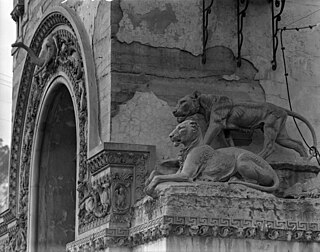
The Selig Zoo in Los Angeles, California was an early 20th century animal collection managed by Col. W.N. Selig for use in Selig Polyscope Company films and as a tourist attraction. Over the years the zoo was also known as the Luna Park Zoo, California Zoological Gardens, Zoopark, and, eventually, Lincoln Amusement Park. After Westerns, "animal pictures" were Selig's second-most popular genre of film product.

SS Catalina, also known as The Great White Steamer, was a 301-foot steamship built in 1924 that provided passenger service on the 26-mile passage between Los Angeles and Santa Catalina Island from 1924 to 1975. According to the Steamship Historical Society of America, Catalina has carried more passengers than any other vessel anywhere. From August 25, 1942, until April 22, 1946, the ship served as the Army troop ferry U.S. Army FS-99 at the San Francisco Port of Embarkation transporting more than 800,000 troops and other military personnel between embarkation camps and the departure piers. After a period of service as a floating discothèque, the ship ran aground on a sandbar in Ensenada Harbor in 1997 and partially sank on the spot. It was scrapped in 2009.

Santa Catalina Island is a rocky island off the coast of Southern California in the Gulf of Santa Catalina. The island covers an area of about 75 square miles. It features a diverse and rugged landscape, including rolling hills, canyons, coastal cliffs, and sandy beaches. The island's highest peak is Mount Orizaba, rising to an elevation of 2,097 feet. The island is 22 mi long and 8 mi across at its largest width. The island is situated in the Pacific Ocean, approximately 29 mi south-southwest of Long Beach, California. Politically, Catalina Island is part of Los Angeles County in District 4. Most of the island's land is unincorporated and is thus governed by the county.
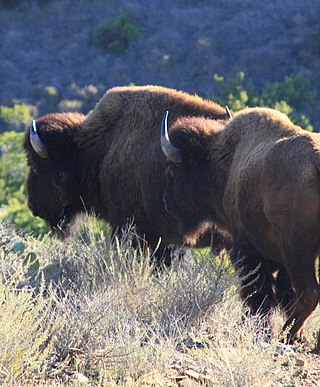
The Catalina Island bison herd is a small group of introduced American bison living on Catalina Island off the coast of Southern California. In 1924, several bison were acquired and, before the end of 1925, brought to Catalina. The bison are now quite popular with the tourists. Some buildings have been painted with images of bison and decorated with bison weather vanes. Over the decades, the bison herd numbered as many as 600. The population currently numbers approximately 100.
David Malcolm Renton, known as "DM", was a builder and business executive in southern California. He is best known for his Craftsman style homes in Pasadena and for the construction of the Casino Ballroom and other homes on Catalina Island in the early 1900s. Renton was influential in the development of Catalina Island under William Wrigley Jr., serving as vice-president of the Santa Catalina Island Company and the Wilmington Transportation Company from 1919 to his retirement in 1936. He also served as president of the Wilmington Catalina Airlines from 1931 to 1942.

Catalina Pottery is the commonly used name for Catalina Clay Products, a division of the Santa Catalina Island Company, which produced brick, tile, tableware and decorative pottery on Santa Catalina Island, California. Catalina Clay Products was founded in 1927. Gladding, McBean & Co. acquired all of the assets of the company in 1937 and moved all production to its Franciscan dinnerware division in Los Angeles.
The Catalina Film Festival is an annual event that takes place at the end of September on Catalina Island, situated in Los Angeles County within the city of Avalon, California.
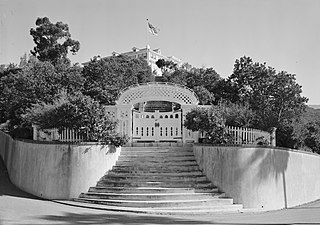
The William Wrigley Jr. Summer Cottage, or "Mount Ada", is a historic residence located at 76 Wrigley Road in Avalon, on Santa Catalina Island, California. It was the former summer mansion and gardens of William Wrigley Jr. (1861–1932), the founder of the Wrigley Company. It is on a hill, overlooking the town and Avalon Bay.
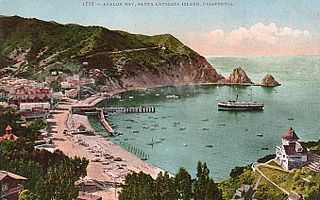
The history of human activity on Santa Catalina Island, California begins with the Native Americans who called the island Pimugna or Pimu and referred to themselves as Pimugnans or Pimuvit. The first Europeans to arrive on Catalina claimed it for the Spanish Empire. Over the years, territorial claims to the island transferred to Mexico and then to the United States. During this time, the island was sporadically used for smuggling, otter hunting, and gold-digging. Catalina was successfully developed into a tourist destination by chewing gum magnate William Wrigley, Jr. beginning in the 1920s, with most of the activity centered around the only incorporated city of Avalon, California. Since the 1970s, most of the island has been administered by the Catalina Island Conservancy.

The Feather Hill Zoo or Feather Hill Ranch Zoo was a U.S. private animal collection in Montecito, California owned by Christian R. Holmes from 1924 to 1930. Featherhill Ranch was located on East Valley Road "astride Romero Creek." Originally a poultry operation, the ranch rapidly established a large collection of birds and animals to attract customers to the site.
